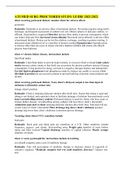Exam (elaborations)
ATI MED SURG PROCTORED STUDY GUIDE 2021/2022 - Correct Questions & Answers with Rationales
- Course
- Institution
ATI MED SURG PROCTORED STUDY GUIDE 2021/2022 client receiving peritoneal dialysis. monitor client for adverse effects peritonitis Rationale: Peritonitis is an adverse effect of peritoneal dialysis. Prevention requires using sterile technique, and frequent assessment of catheter exit site. Obtain cu...
[Show more]



